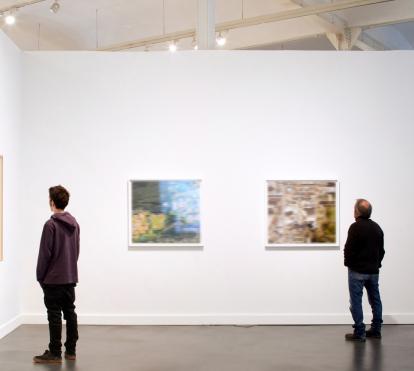
"I'll donate all of this the music mementoes, paintings and papers at Sant Salvador to my country," the exiled Pau Casals once declared. The place he was referring to was Villa Casals, the house the musician had built on the Sant Salvador beachfront, which he later filled with works of art. With the title Pau Casals on the art scene, the Villa Casals Collection, ”la Caixa” Foundation presents in Granollers the artist's collection of 48 paintings and sculptures he either purchased or commissioned to decorate the house, especially his study, and that span a rich repertoire of Catalan art: Ramon Casas, Joaquim Mir, Joan Rebull, Martí Alsina, Josep Llimona, Eliseu Meifrèn, Ricard Opisso, Xavier Gosé, Santiago Rusiñol, Joaquim Sunyer, and others. Moving beyond his public persona, the showing invites visitors to familiarise themselves with another side of the musician (that of an enthusiastic art lover and ardent collector), while looking upon the chief works of reference that so captivated him. This exhibition, put on in Granollers the first time the works have been removed from their original location at Villa Casals (a house-museum since 1976) is organised and produced by ”la Caixa” Foundation in conjunction with the Pau Casals Foundation. The show will later travel to other points of Catalonia in the effort to share the master's artistic compilation with the largest possible viewing public.The exhibition Pau Casals on the art scene. The Villa Casals Collection, curated by Laura Mercader, can be visited at ”la Caixa” Foundation's Granollers Cultural Centre (Joan Camps, 1) from 11 September to 30 November, 2003. The showing features 48 pieces (sculptures and paintings for the most part, but also drawings, lithographs and etchings) that walk viewers through late 19th and early 20th century Catalan art: from the forerunners of modern art like Martí Alsina, Joan Roig Soler and Eliseu Meifrèn to the realists of the 1920's and 30's, such as Rafael Benet, Domènec Carles, Francesc Labarta, Josep Mompou, Joan Rebull and Alfred Sisquella. Casals purchased many of these artists' works through art dealer Joan Merli.Three names especially stand out among the artists whose work is present in the exhibit: Eugène Carrière, Ramon Casas and Joaquim Mir. Carrière and Casas both painted the musician's portrait with just a few years' difference. French symbolist Eugène Carrière was one of Casals's closest friends, at the great cellist's side when he passed away. The landscapes painted by Mir who settled in Vilanova in the 1930's are highly reminiscent of the musician's home territory. They are proof that, beyond its aesthetic value, art had an essential human dimension for Casals. Pau Casals and Villa CasalsPau Casals (el Vendrell, 1876 - Puerto Rico, 1973) is world-renowned for his contribution to contemporary music, as a composer, symphony director and the greatest cellist of the 20th century. Collective memory also retains the image of an individual committed to the freedom of mankind, a veritable ambassador of peace. That was his public persona. Nonetheless, behind it there was a simple family man with a great sensibility toward anything having to do with culture. Simply strolling through Villa Casals reveals this more private figure, while also giving rise to another: that of an art lover and uncompromising collector. Now, under the eaves of Villa Casals, we invite you to discover this other side to the musician, while looking upon the chief works of reference that held his attention. From his exile, Casals made clear his desire that all of the mementoes in the Sant Salvador house become part of his homeland's heritage. Thus, the idea to turn Villa Casals into a museum emerged. In fact, Villa Casals was already a private museum during the musician's life. In the beginning, it was a modest summer home where Casals rested up between tours. But once he established his residence in Barcelona, the house became the setting in which to represent his public image and a meeting place for his friends. Architect Antoni Puig Gairalt remodelled it into a stately Italian-style villa of noble character. The garden, lorded over by Josep Clarà's Apol·lo and the female nude by Josep Llimona, and the interior Vigatà Room, are the most significant results of this makeover.Puig Gairalt's renovation sparked Pau Casals's artistic sensibility, a facet he had begun to cultivate with Count Morphy in Madrid and in the cultural ambience of Barcelona and Paris drawing rooms. Advised by gallery owners and critics, the musician personally selected the works of art that would decorate the house, especially his study. The Collection consists of paintings and sculptures by the most widely-known Catalan artists of the late 19th and early 20th century, from realists to impressionists and expressionists, including Cezannians and followers of the late currents of German New Objectivity. The cohesive quality of the collection has rendered it an ideal set of works to revisit fifty years' worth of realist art history in Catalonia. Pau Casals on the art scene. The Villa Casals CollectionFrom 11 September to 30 November, 2003”la Caixa” Foundation Cultural CentreJoan Camps, 108400 Granollerswww.fundacio.lacaixa.esTel.: 902 22 30 40HoursMonday to Friday, 5 to 9 pm Saturdays, 10 am to 2 pm and 5 to 9 pmSundays and holidays, 11 am to 3 pmFree admissionwww.fundacio.lacaixa.es